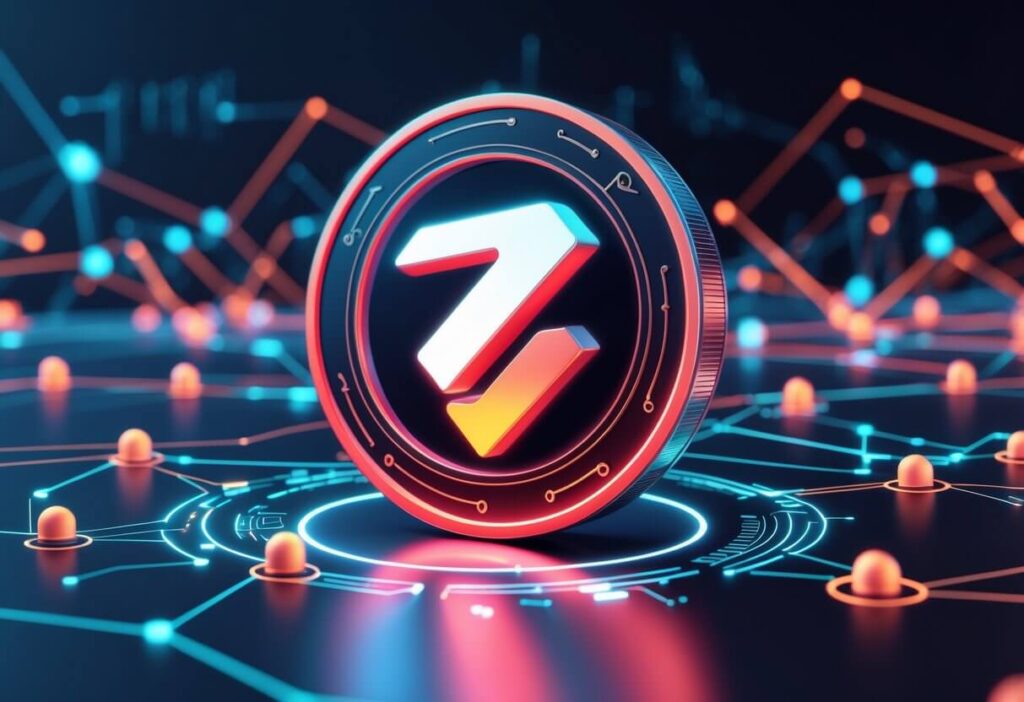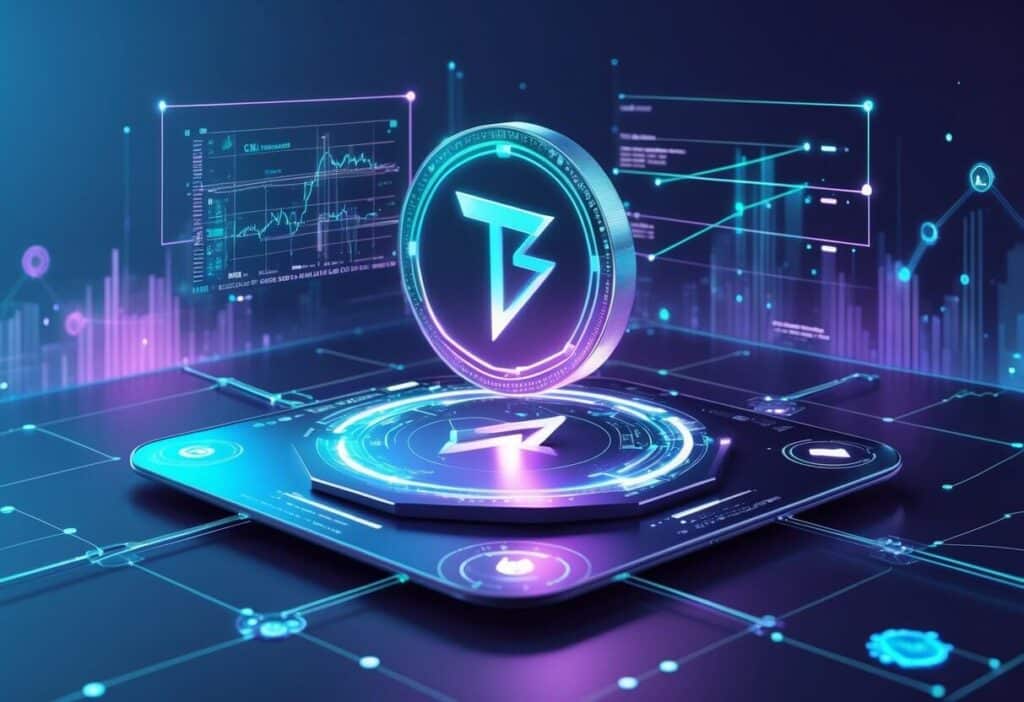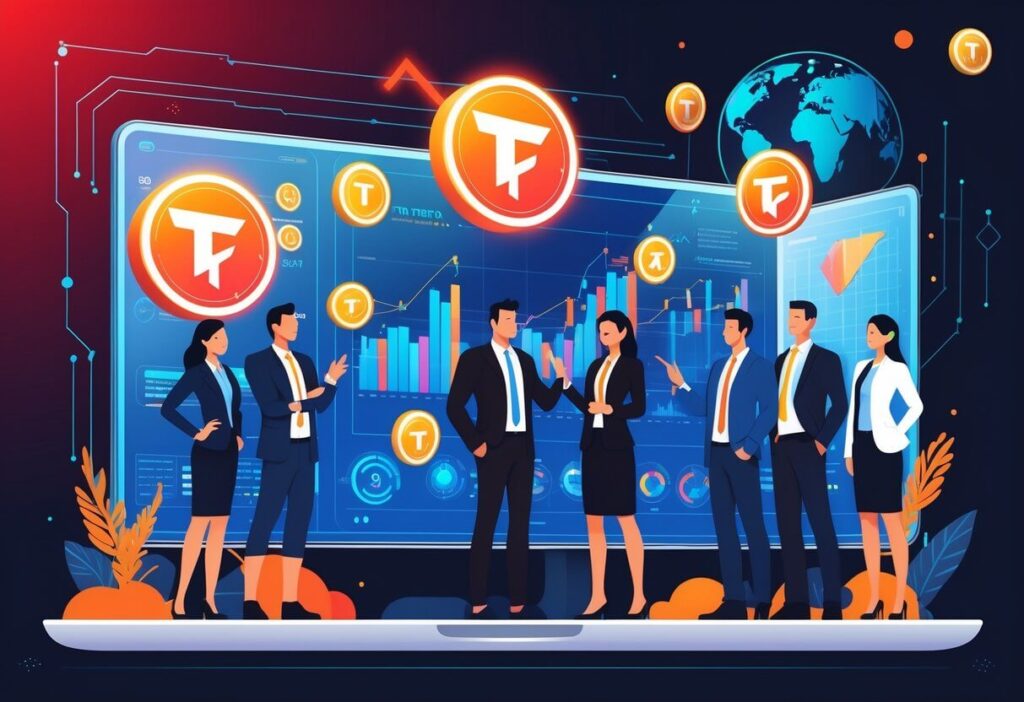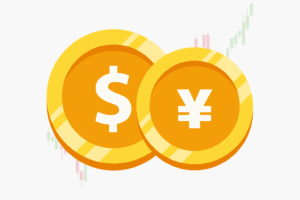TRX is the native cryptocurrency of the TRON blockchain network, a platform designed for building decentralized applications and smart contracts. TRON operates as a blockchain-based digital platform that allows developers to create decentralized applications while using TRX tokens for transactions and staking rewards.

What makes TRON different from other blockchains is its unique approach to transaction fees and consensus mechanism. Unlike Ethereum, TRON uses bandwidth points as payments rather than charging gas fees in its native token. This system gives users 600 bandwidth points by default, and they can stake TRX to get more bandwidth when needed.
I’ll walk you through everything you need to know about TRX and TRON, from its origins as a content-sharing platform to its current role as a major blockchain network. You’ll learn how the platform works, its evolution over the years, and what makes it attractive to developers and investors today.
Want to know What TRX is trading at? look at our TRX Price Analysis.
Key Takeaways
- TRX is the native cryptocurrency of the TRON blockchain, which focuses on decentralized applications and smart contracts
- TRON uses a unique bandwidth point system instead of traditional gas fees, making transactions more cost-effective
- The platform has evolved from a content-sharing network to a major blockchain infrastructure with billions in market capitalization
Overview of TRX (TRON)
TRX is the native cryptocurrency of the TRON blockchain platform. I’ve found that TRON operates as a decentralized blockchain designed specifically for building and running decentralized applications.
The TRON ecosystem runs on blockchain technology that focuses on content sharing and entertainment applications. Unlike many other cryptocurrencies, TRX is not used to pay transaction fees on the network.
Key TRX Features:
- Native token: Powers the TRON blockchain ecosystem
- Staking rewards: Users can stake TRX to earn rewards
- Governance: TRX holders vote for network representatives
- Bandwidth: Staking TRX provides bandwidth points for transactions
The blockchain platform uses a system called Delegated Proof of Stake. This means I can stake my TRX tokens to help secure the network and earn rewards.
TRX Tokenomics:
- Total Supply: Over 100 billion TRX tokens
- Consensus: Delegated Proof of Stake mechanism
- Staking: Required for network participation
- Voting: Token holders elect 27 super representatives
The TRON blockchain ecosystem supports smart contracts and decentralized applications. I can use TRX within various applications built on the platform.
TRX transactions are fast and typically cost less than a dollar in fees. The blockchain technology behind TRON aims to create a decentralized internet where content creators can connect directly with consumers.
History & Evolution
TRON launched in 2017 when Justin Sun published the whitepaper in September. The document outlined a platform focused on decentralizing the internet through content and entertainment.
Within one month of launch, the project raised $70 million. They sold 15.75 billion TRX tokens at $0.002 each during the initial coin offering.
Major Milestones:
- 2017: ICO launch and whitepaper release
- 2018: Migration from Ethereum to independent blockchain
- 2019: BitTorrent acquisition
- 2020-2021: DeFi expansion and cross-chain support
- 2022-2023: Metaverse and GameFi focus
The platform initially ran as an ERC-20 token on Ethereum. In May 2018, TRON migrated to its own MainNet, giving the team full control over development.
June 2018 brought the Odyssey 2.0 update. This introduced smart contracts and the Tron Virtual Machine (TVM).
A major turning point came in February 2019 when the Tron Foundation acquired BitTorrent. This peer-to-peer platform brought 100 million users into TRON’s ecosystem.
The acquisition led to Project Atlas. This initiative merged BitTorrent with TRON’s blockchain, allowing users to earn TRX for sharing files.
Between 2020-2021, TRON expanded into DeFi. They launched USDD, an algorithmic stablecoin that reached over $700 million market cap by 2023.
Recent years have seen TRON focus on gaming and NFTs. They partnered with APENFT Foundation and integrated TRX into various gaming platforms.
Composition & Sector Weights

The TRON network’s composition centers around its native cryptocurrency TRX, which serves as the primary asset for transactions and governance. TRX was created with a total supply of 100 billion tokens during its 2017 initial coin offering.
Token Distribution Breakdown:
- Public Sale: 40 billion TRX (40%)
- Private Sale: 15 billion TRX (15%)
- TRON Foundation: 35 billion TRX (35%)
- Peiwo (Initial Supporter): 10 billion TRX (10%)
The network’s sector composition spans multiple blockchain use cases. DeFi protocols represent the largest sector by transaction volume, with billions in stablecoin transfers flowing through TRON daily.
Primary Sector Weights:
- DeFi & Stablecoins: Highest transaction volume
- Gaming & Entertainment: Growing application layer
- NFT Marketplaces: Expanding ecosystem presence
- Payment Protocols: Cross-border transactions
I find that TRON’s governance structure uses a delegated proof-of-stake system where 27 Super Representatives validate transactions. Token holders vote every six hours to elect these representatives.
The smallest unit of TRX is called a “sun,” named after founder Justin Sun. Any tron wallet can hold these denominations for staking, voting, or transactions across the network’s various sectors.
Calculation Methodology

I find that TRON’s calculation methodology centers on its Delegated Proof-of-Stake (DPoS) consensus mechanism. This system uses 27 Super Representatives who validate transactions and produce blocks.
The TRON network calculates transaction fees based on two main resources: bandwidth and energy. Each account receives 600 free bandwidth points daily for basic transactions.
When I examine smart contract operations, the TRON Virtual Machine (TVM) processes these using Energy consumption. TRC-20 token transfers require both bandwidth and energy resources.
Resource Calculation Formula
| Resource Type | Formula | Cost |
|---|---|---|
| Bandwidth | Transaction bytes × 1 unit | 1,000 sun per unit |
| Energy | Smart contract operations | 210 sun per unit |
The network uses a dynamic energy model that adjusts costs based on contract popularity. Popular contracts consume more energy during high-usage periods.
I observe that Super Representatives play a crucial role in network governance and transaction validation. The DPoS system ensures fast processing while maintaining decentralization through voting mechanisms.
Smart contracts written in Solidity execute on the TVM, consuming energy based on computational complexity. The resource model allocates fixed daily supplies: 43.2 billion bandwidth units and 180 billion energy units network-wide.
Users can stake TRX to obtain additional bandwidth and energy resources, reducing transaction costs significantly.
Significance & Common Uses
TRX serves as the backbone of the TRON ecosystem, powering multiple essential functions across the network. I’ve observed that TRX primarily functions as a payment method for transaction fees on the TRON blockchain.
Payment and Transaction Processing
The most significant use of TRX is paying for network operations. Users need TRX to interact with decentralized applications, deploy smart contracts, and transfer tokens. The extremely low transaction fees, often less than $0.01, make these interactions highly accessible.
DeFi Applications
TRX powers major decentralized finance platforms like JustLend and JustSwap. These DApps enable users to lend, borrow, and trade cryptocurrencies. Yield farming opportunities allow TRX holders to earn rewards by providing liquidity.
Digital Content and Entertainment
The integration with BitTorrent creates a massive use case for TRX. Content creators can monetize their work directly through the platform. Users earn BTT tokens and TRX for file sharing activities.
Staking and Governance
TRX holders can stake their tokens to earn passive income. Staking yields generally range between 3% and 7% annually. Each token also provides voting rights for network governance decisions.
Gaming and NFTs
Blockchain games built on TRON use TRX for in-game transactions. The APENFT marketplace facilitates NFT trading using TRX. The network’s high throughput of 2,000 transactions per second supports these applications effectively.
Ecosystem Integration
TRX works alongside stablecoins like Tether on the TRON network. This creates a comprehensive financial ecosystem for users and developers.
How to Invest (No Advice)

I can outline the basic steps for purchasing TRX tokens. This information is for educational purposes only and should not be considered investment advice.
Step 1: Choose an Exchange
You’ll need to select a cryptocurrency exchange that supports TRX trading. Popular exchanges include Binance, Kraken, and OKX for TRX purchases.
Poloniex also offers TRX trading pairs for those who prefer that platform.
Step 2: Account Setup
I recommend completing the following tasks:
- Create your exchange account
- Complete identity verification (KYC)
- Enable two-factor authentication
- Review the exchange’s fee structure
Step 3: Fund Your Account
Most exchanges accept these funding methods:
| Method | Processing Time | Typical Fees |
|---|---|---|
| Bank transfer | 1-3 days | Low |
| Credit card | Instant | Higher |
| Cryptocurrency | Minutes | Variable |
Step 4: Place Your Order
You can buy TRON through market orders or limit orders. Market orders execute immediately at current prices. Limit orders let you set your preferred price.
Step 5: Secure Storage
Consider withdrawing TRX to a personal wallet rather than keeping it on the exchange. TronLink is a popular wallet option for storing TRX tokens.
Remember that cryptocurrency investments carry significant risks. I suggest doing thorough research before making any financial decisions.
Common Questions on TRX (TRON)
TRX operates on a fixed validation schedule with super representatives rotating every 6 hours. The main differences between TRX and competing blockchains like Ethereum and Solana lie in their consensus mechanisms and transaction costs.
How Often Is the Index Reviewed?
The TRON network doesn’t use a traditional index system. Instead, it operates on a continuous validation cycle where 27 super representatives validate blocks every 3 seconds.
Elections for super representatives happen automatically every 6 hours. This means the network constantly reviews and updates its validator set based on community votes.
TRX holders can vote for their preferred super representatives at any time. The voting power equals the amount of TRX tokens held.
The system differs from Ethereum’s proof-of-stake, which has longer validation periods. Solana uses a similar fast block time but with different validator selection methods.
This frequent rotation prevents power concentration. It ensures only the most reliable validators maintain their positions on the network.
What’s the Difference Between TRX (TRON) and Close Peer?
TRX uses Delegated Proof of Stake (DPoS) while Ethereum uses standard proof-of-stake. This gives TRX faster transaction speeds of 2,000 transactions per second compared to Ethereum’s 15 transactions per second.
Transaction costs represent the biggest difference. TRX fees stay below $0.01 while Ethereum fees can reach $50 during network congestion.
Solana offers similar speed to TRX but uses a different consensus called proof-of-history. Cardano uses Ouroboros proof-of-stake with slower transaction speeds than TRX.
TRX is compatible with the Ethereum Virtual Machine, making it easy for developers to port applications. Polkadot uses a completely different parachain architecture.
The energy consumption of TRX is much lower than Ethereum’s previous proof-of-work system. This makes TRX more environmentally friendly than many competitors.
Where Can I Track the Index Live?
I can track TRX prices on major cryptocurrency exchanges like Binance, Coinbase, and Kraken. These platforms show real-time price data and trading volumes.
CoinMarketCap and CoinGecko provide comprehensive TRX tracking with market cap rankings. They show TRX typically maintains a position in the top 15 cryptocurrencies by market value.
TRON’s official blockchain explorer called TRONSCAN displays network statistics. It shows live transaction data, super representative information, and staking rewards.
TradingView offers advanced charting tools for TRX price analysis. Multiple cryptocurrency portfolio apps also include TRX tracking features.
The TRX market cap currently sits around $25 billion with 94 billion tokens in circulation. Daily trading volumes regularly exceed $200 million across all exchanges.
Frequently Asked Questions
TRX wallets provide secure storage and transaction capabilities within the Tron ecosystem. Payment methods, price factors, and the TRC20 standard shape how users interact with the network.
A TRX wallet stores your private keys and manages your Tron tokens on the blockchain. The wallet connects to the Tron network to send and receive TRX tokens.
I recommend using hardware wallets like Nano Ledger S for maximum security. Multiple wallet options exist including Atomic wallet, Tronscan web wallet, and paper wallets.
The main benefit is complete control over your tokens. You own your private keys instead of trusting an exchange to hold your funds.
TRX wallets also let you participate in network governance. You can vote for super representatives and earn rewards through staking.
TRX works as a payment method through direct wallet-to-wallet transfers. You can send TRX to any valid Tron address within seconds.
The biggest advantage is extremely low transaction fees. Tron provides 5,000 free bandwidth points daily to users, making most transactions free.
Payment processing is fast with 2,000 transactions per second capacity. This beats Bitcoin’s 7 TPS and Ethereum’s 15 TPS significantly.
Smart contracts enable automated payments and escrow services. Developers can build payment systems that execute automatically when conditions are met.
Network adoption drives TRX price through increased demand. More users and transactions create higher utility for the token.
Developer activity affects price as new applications attract users. Tron supports decentralized applications and smart contracts which expand the ecosystem.
Market sentiment and crypto regulations impact all cryptocurrencies including TRX. Bitcoin price movements often influence altcoin prices.
I cannot provide specific price predictions for 2025. Cryptocurrency markets are highly volatile and unpredictable.
Tron focuses on content delivery and distribution through decentralized applications. Content creators can connect directly with their audience.
The network supports lending platforms and decentralized exchanges. Projects like JustLend allow community-based borrowing and lending.
Gaming applications use TRX as in-game currency. Players can earn and spend tokens within blockchain-based games.
TRX enables crowdfunding and airdrop participation. Users can support projects and receive token distributions.
TRC20 is Tron’s token standard similar to Ethereum’s ERC20. It defines how tokens operate on the Tron blockchain.
Developers can create custom tokens following TRC20 rules. This ensures compatibility with Tron wallets and exchanges.
Users benefit from standardized token behavior. All TRC20 tokens work the same way in wallets and applications.
The standard reduces development complexity. Developers don’t need to build custom wallet integrations for each token.
The Tron Foundation governs the overall network and guides development decisions. They coordinate protocol upgrades and improvements.
The foundation manages network parameters and consensus rules. They work with super representatives to implement changes.
Development funding comes from the foundation’s resources. They support projects that expand the Tron ecosystem.
The foundation launched Tron in 2017 under CEO Justin Sun’s leadership. They continue overseeing the project’s strategic direction.





